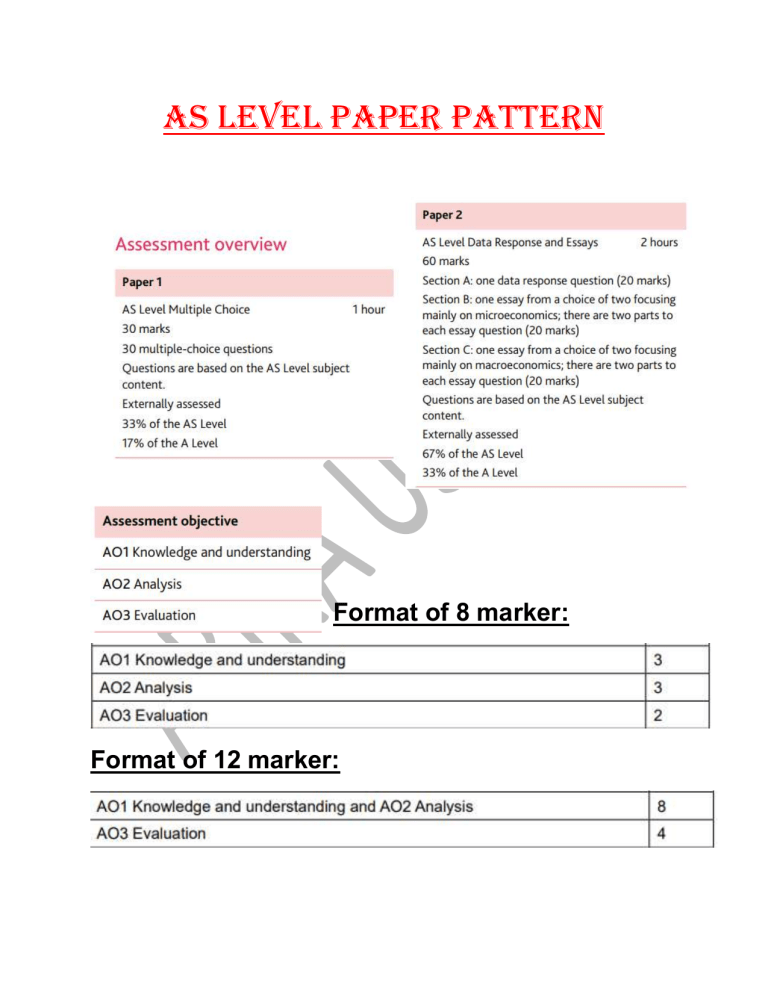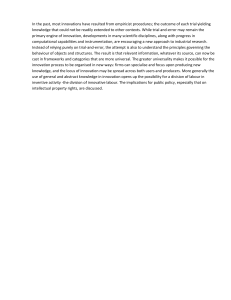
AS LEVEL PAPER PATTERN Format of 8 marker: Format of 12 marker: The 2030 agenda for sustainable development was set up by UN in 2015 -UNIT 1 Important definitions Economics??? (as many def as economists) (Social science) How people engage themselves in Pr, distribution & C of goods and services in a society How society manages scarce resources in an efficient way to max private & social welfare Micro economics: refers to specific economic units. It deals with the decision making of individuals and firms and how a particular mkt works. Macro economics: focuses on the economy as a whole. It is the study of aggregates like unemployment, inflation, BOP, living standards, AS and AD NEEDS: things without which, survival is difficult e.g. food, clothing, shelter, air. All people have the same basic needs. WANTS: These are our wishes and desires. They are unlimited. Everyone has unlimited wants Wants are different according circumstances (old vs young) to people in different Wants can be conflicting (poor vs rich) SCARCITY: means there is only a limited or finite number of resources FREE GOOD: It is a resource that is unlimited in supply and does not require resources for production e.g. sea water, sand, air. ECONOMIC GOODS: These are goods that are limited in supply and have a price to be paid e.g. food, electricity etc. RESOURCE: is the input that goes into the production of goods and services. Factor of production (FOP): a resource used to produce goods and services. Scarce resources: FOP SDG 6? Water situation Land: in balochistan. natural resource above, below, on, over the land reward for owning land: rent SDG13? Drought in renewable (forests) & non-renewable (oil, gas) Ethopia Labour: human resource, pop, working pop, all those ppl who are able & willing to work and putting in mental or physical effort to produce G&S. reward: wage/salary Capital: man made resources that help in the pr of other goods n services that are not valuable themselves not related to financial capital held in bank, not bonds or stocks, money reward: interest/ rate of return that one earns are manufactured using other FOPs includes assets and owner’s equity private, personal house is not capital but commercial aircraft is capital capital goods increase land & Labor efficiency (more output at lower cost) Is money a resource? NO. Entrepreneur: person who takes risk + organizes FOPs to carry out an eco activity Risk in free enterprise small enterprise, entrepreneur does all function big firm: managers +shareholders return is profit The entrepreneur does four things: comes up with new ideas brings all the other resources together makes the basic decisions, and takes the risks to earn profits (or losses. The payment for each type of resource has it's own term. 1. land -- rent 2. capital -- interest 3. labor -- wages 4. entrepreneurial ability -- profits or losses Activity: link SDG with different FOPs and briefly explain how achieving one goal might help improve the quality and quantity of production factor. large factor endowment : High quality and large amount of FOP: developing coutries( large labour & capital but low entrepreneurial experience) vs developed countries Production resources combined to produce G&S to satisfy needs and wants of ppl Consumption: SDG 12 Responsible Consumption & production Spending by ppl on G&S to satisfy their needs & wants Ceteris paribus: “all other variables remain constant” –simplifies an actual situation— assumption all other things except the variable to be studied are unchanged—model 1 change at a time/ effect of change in one variable is considered in isolation Time dimension: (no time scale though) short run: possible to change at least 1 variable usually labour (more hiring or increase part time work) long run : all FOP can increase in size and quality very long run (FOPs and key inputs like tech, regulations are variable Positive and normative statements: Positive: Factual, objective statements (i.e facts that are right or wrong or that can be proven) /“abt measurable things” normative: “value jugdement that can be argued” “ opinion” “abt policies” “words such as should, must, welfare, harmful, unfair” Ques: Prepare different normative and positive statements using SDGs. ans: A decrease in poverty will inevitably lead to good health and well-being SDG 1 & 3 No poverty Health & well being Specialization: whereby individual firms, regions and nations concentrate on producing specific goods. Esp what they r best (have an advantage over) at. E.g in household, workplaces but no one is self -sufficient – if u specialize in a particular task, more is produced than can be Consumed __surplus is accumulated which can be traded regional & national specialization in what they were good - increased world output-higher incomes __ ↑SOL (standard of living) Division of labour : whereby the production process is broken down into various tasks and each worker focuses on the task, he is best able to perform. It is only possible when workers become more specialised. Specialization leads to Division of labour. 7 ADVANTAGES OF ‘THE DIVISION OF LABOUR’ increase productivity (max output per labour) & lower AC of production. More output & massive improvement in living standards): Division of labour increases the skill & speed of workers __more output___more income__higher SOL No time is wasted in moving from one job to another There is saving of equipment. If workers specialize, they will not need to have a full set of tools or other equipment. This saves costs. There is saving of training time & training costs as a person has to learn a single task rather than a no. of them. Specialization is possible as each worker can specialize in the job he is interested in or is good at. Full use is made of employees’ abilities. Mechanisation is possible: a complex process has been broken down into separate simpler processes and it is possible to devise machinery to carry out each individual operation. With advances in technology it is becoming possible to mechanise more areas of production. Benefit can be gained from using specialist machinery: Result is higher output, low per unit costs, and better quality: which leads to eco growth as more needs and wants can be satisfied with the given scarce resources. 5 DISADVANTAGES OF THE DIVISION OF LABOUR: Loss of flexibility: substitution for a specialist worker is difficult in case of absence Monotony: boredom, higher labour turnover (leaving the jobs), low productivity , dehumanizing Workers feel alienated: cannot relate to the final product (feel no connection) Specialist labour may become Redundant as eco develops : don’t possess wide range of skills. When demand or supply conditions change, their particular skills may no-longer be needed. Products may become too standardized : Usually mass production takes place whereby same products are made for the masses. Lack of variety. International Division of labour is encouraged by: Better transport systems Free trade __ no import taxes or controls Stable international exchange rates __ so trade can be planned




